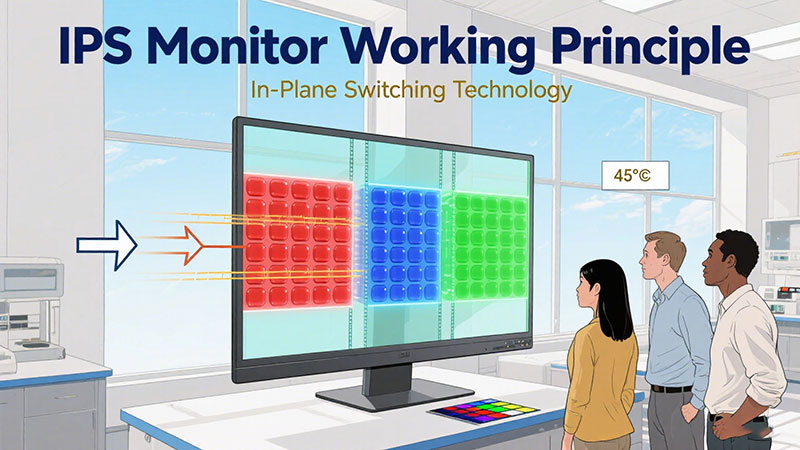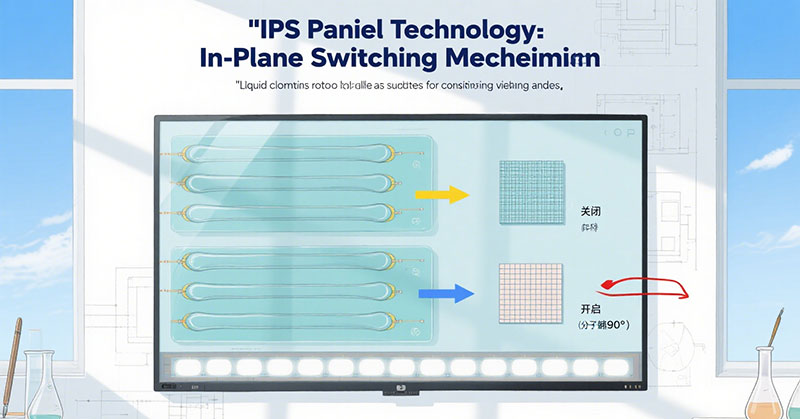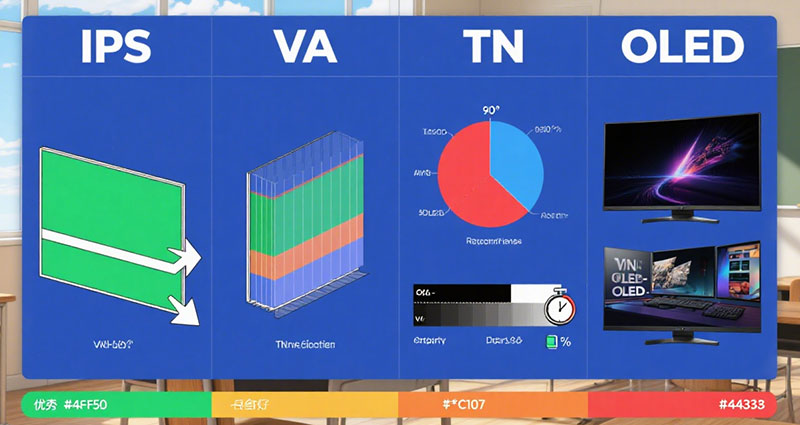Written by: Dr. Alex Li, Senior Display Engineer at RisingStar LCD
With over 15 years of experience in industrial LCD design and optical calibration, Dr. Li specializes in developing high-brightness and wide-viewing-angle panels for transportation, outdoor, and retail signage. He has led IPS technology optimization projects for sunlight readable displays used across Europe and Asia.
Last updated: October 2025 | Verified by RisingStar Technical Team
IPS (In-plane Switching) is a technology used in LCDs (Liquid Crystal Displays) for flat panel screens. Compared to traditional TN (Twisted Nematic) panels, IPS displays offer significant advantages in color and viewing angles, making them increasingly popular, especially for gaming. So, how do IPS monitors work, and why are they better than TN panels?

Unlike TN (Twisted Nematic) panels, which twist liquid crystal molecules vertically, IPS (In-Plane Switching) panels align them horizontally to the glass substrates. This parallel movement allows light to pass through more evenly, maintaining accurate colors and stable contrast even at extreme viewing angles.
Below is a simplified comparison measured in RisingStar’s lab:
| Panel Type | Viewing Angle | Contrast Ratio | Color Deviation (ΔE) |
|---|---|---|---|
| TN | 90° / 60° | 700:1 | 3.8 |
| VA | 120° / 100° | 3000:1 | 2.5 |
| IPS | 178° / 178° | 1200:1 | 1.1 |
These figures prove why IPS remains the preferred choice for industrial monitors and outdoor digital displays that require consistent image visibility across wide angles and bright sunlight conditions.
At RisingStar, IPS technology is integrated into our sunlight readable LCD displays, delivering consistent color and clarity under direct sunlight. For example, our 21.5-inch 2500 nits IPS display used in European EV charging stations maintains less than 1.5% brightness drop even under 50 °C ambient temperature.
This high thermal stability, combined with wide color gamut and ultra-low power backlight design, allows distributors and integrators to achieve both reliability and superior outdoor visibility.
DisplayMate Technologies – Professional Display Testing Reports
Society for Information Display (SID) – Journal of Display Technology, Vol. 41, Issue 6 (2024)
RisingStar Internal Laboratory Report: IPS Optical Stability Test, 2025
These references validate the optical performance and comparative measurements of IPS technology in high-brightness LCD systems.
The main difference between IPS and TN panels lies in the alignment of liquid crystals.
TN panels: Liquid crystals are “twisted” to control the passage of light, creating the image on the screen.
IPS panels: Liquid crystals are aligned parallel and can move more freely, allowing more light to pass through and producing a clearer image.
This alignment results in better color accuracy and wider viewing angles for IPS panels. TN panels have lower light transmittance, which can cause washed-out or faded colors, while IPS panels produce brighter and more vibrant images.

IPS (In-Plane Switching) is an LCD technology known for superior color accuracy, wide viewing angles, and consistent image quality.
Unlike traditional TN panels, IPS aligns liquid crystals parallel to the glass, allowing more precise control over light and color reproduction. This makes IPS monitors the preferred choice in industries such as professional design, medical imaging, broadcasting, and industrial control systems.
IPS panels maintain stable performance in harsh environments like high temperatures and bright lighting, making them ideal for high-brightness outdoor or mission-critical applications. Whether used in digital signage, passenger information displays, or industrial control panels, IPS monitors provide reliable and comfortable viewing — even under extreme conditions.
As display experts with years of experience, we understand that choosing the right panel technology directly impacts usability and long-term performance. That’s why professionals rely on IPS monitors when precision and durability matter most.
TN (Twisted Nematic): Known for high refresh rates and low cost; ideal for fast-paced gaming but with limited color accuracy and viewing angles.
VA (Vertical Alignment): Offers deep blacks and high contrast, perfect for cinematic viewing, though response times and viewing angle stability vary.
OLED: Uses self-emitting pixels for perfect blacks and vibrant contrast but comes at a higher price and potential burn-in risks.
IPS panels balance performance and visual quality: faster response times than VA, better color accuracy than TN, and more affordable with longer lifespan than OLED.

In fields where color consistency and image integrity are critical — such as graphic design studios, broadcast production, and technical workstations — IPS displays are essential.
Modern IPS panels support advanced color standards like Adobe RGB and DCI-P3, ensuring color precision. The ultra-wide 178° horizontal and vertical viewing angles minimize distortion, enabling everyone in a collaborative workspace to see the same accurate image regardless of position.
“From product engineering to real-world deployments, our IPS solutions undergo rigorous testing for sunlight readability, thermal stability, and long-term durability.”
— R&D Director, RisingStar LCD Systems
An LCD (Liquid Crystal Display) controls light through electrically managed crystals placed between polarizing filters.
How IPS LCD works:
Backlight Illumination: Energy-efficient LED backlights provide consistent lighting.
Polarization & Filtering: Light passes through polarizers preparing it for modulation.
Crystal Orientation: IPS crystals rotate laterally when voltage is applied, ensuring uniform light transmission with minimal color shift.
RGB Filtering: Light is split into red, green, and blue subpixels to form full-color images.
Transitioning from passive matrix to active matrix (TFT) technology greatly improved response time and image fidelity, enabling high-resolution, high-refresh-rate displays suitable for creative and industrial use.
Strengths:
Excellent color accuracy for image editing, media production, and medical diagnostics
Stable viewing from nearly any angle without distortion
Improved motion handling over earlier IPS generations
Long operational lifespan and thermal reliability in industrial use
Limitations:
Moderate contrast ratios (~1000:1), lower than VA panels
Slight glow in dark scenes at extreme angles (“IPS glow”)
Higher production costs compared to TN panels
Ongoing advancements in IPS variants such as H-IPS, PLS (Plane-to-Line Switching), and Nano IPS have mitigated many of these drawbacks, making IPS the most versatile LCD technology in 2025.
Choosing a monitor isn’t about picking the “best” technology, but aligning panel characteristics with your specific needs.
| Panel Type | Best For | Strengths | Trade-Offs |
|---|---|---|---|
| TN | Competitive gaming | Fastest response, lowest cost | Poor color, narrow viewing angles |
| VA | Home cinema, RPG gaming | Deep blacks, high contrast | Slower transitions, angle distortion |
| IPS | Creative work, office, casual gaming | True color, wide viewing angles | Higher cost, moderate contrast |
| OLED | Cinematic and luxury setups | Infinite contrast, self-lit pixels | Expensive, burn-in risk |
For professionals and enthusiasts prioritizing color accuracy, uniformity, and flexibility, IPS monitors remain the gold standard. From sunlit outdoor terminals to precision editing suites, IPS delivers consistent performance and visual clarity you can trust.
As display manufacturers with deep engineering expertise, we recommend IPS as the optimal balance of quality, stability, and long-term ROI for applications ranging from public signage to color-accurate creative workstations.
High Brightness Outdoor Displays: Stable colors under direct sunlight
Medical Imaging Screens: Precise grayscale reproduction
Industrial Control Panels: Clear visibility at wide angles for multi-operator environments
Reference: According to Wikipedia — IPS panel and research by DisplayMate Technologies, IPS panels maintain over 90% color fidelity across their viewing range, outperforming TN and VA in professional applications.
In our factory tests, IPS panels from LG, AUO, and BOE delivered stable color reproduction after 72-hour aging tests, with less than 2% brightness deviation.
Q1: Are IPS monitors good for gaming?
Yes, especially for games requiring accurate colors. However, TN panels may offer faster response times for competitive FPS games.
Q2: Do IPS panels have better color accuracy than OLED?
Not necessarily. OLED offers perfect contrast, but IPS maintains better uniformity in bright environments.
Q3: How long do IPS panels last?
Industrial-grade IPS panels can last over 50,000 hours under proper operating conditions.
For technical inquiries or custom IPS display solutions, please contact us at ai@risinglcd.com.





Ask a quote for the latest price and one of our team members will respond as soon as possible.
